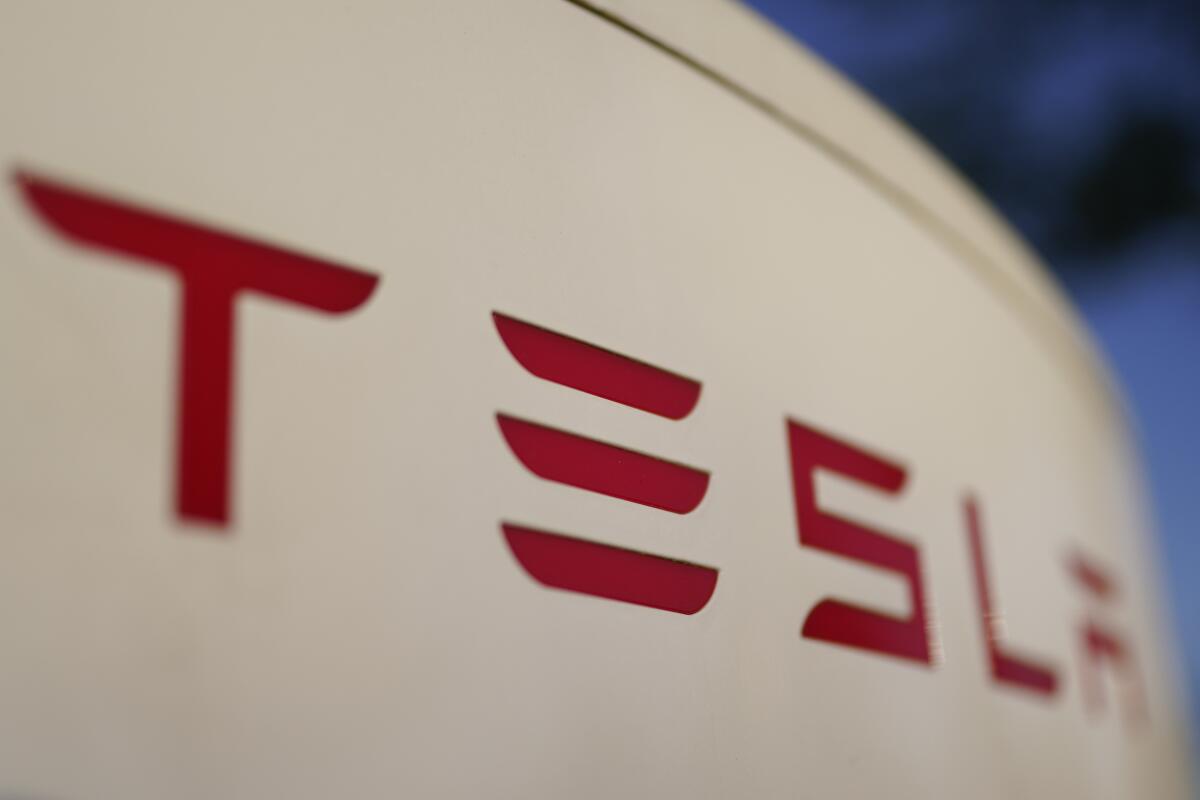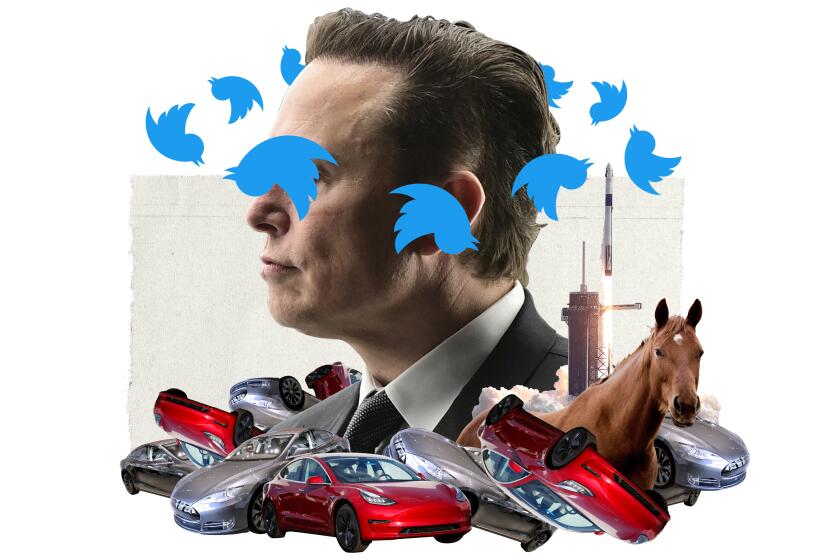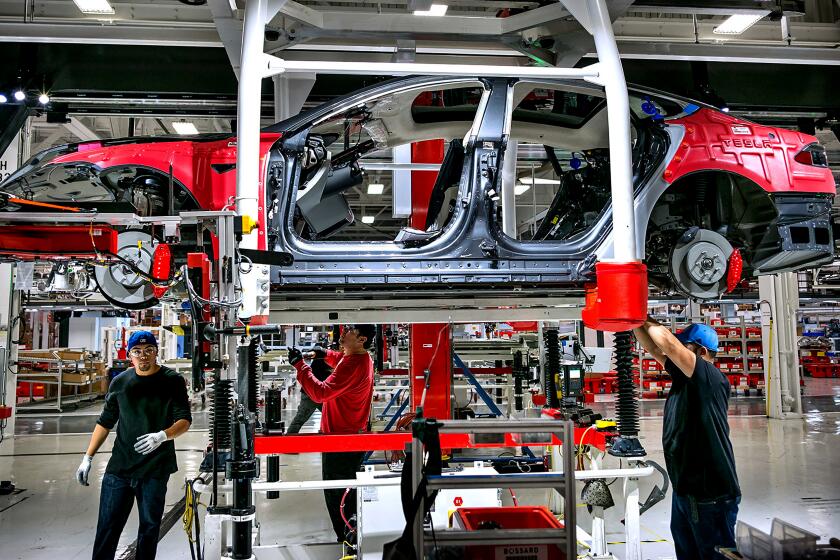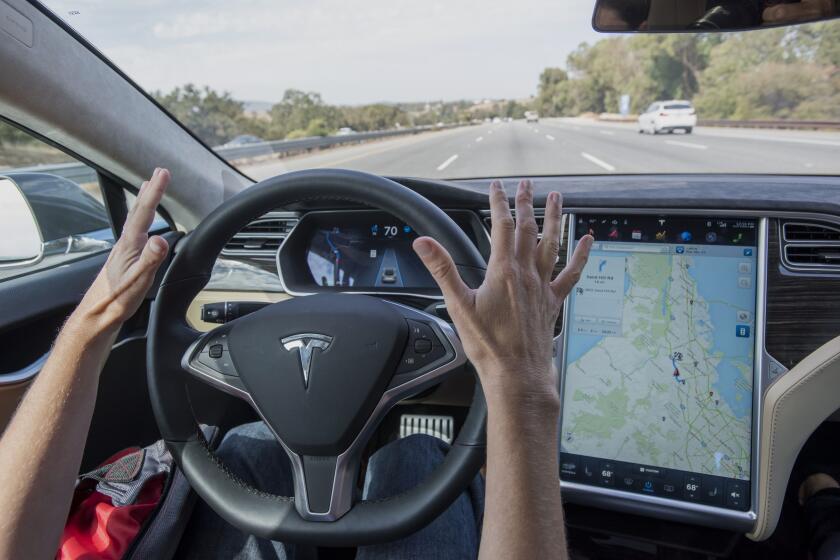What to expect from Elon Musk’s third master Tesla plan

- Share via
Tesla’s stock tends to do well when the electric-car maker is growing like gangbusters and Elon Musk is thrilling fans about a brighter future.
The chief executive officer has shaken off a forgettable 2022 of slower expansion and Twitter diversion by slashing prices and scheduling another showcase of Tesla’s outlook for the next few years. The moves have worked, at least for the time being. Demand picked back up after Tesla discounted models across its lineup by as much as 20%, and the Musk faithful are frenzied about the master plan he’ll deliver Wednesday at the company’s factory in Austin, Texas.
Tesla shares have soared from the two-year low they plumbed in early January, adding roughly $310 billion of market value and returning Musk to the top of the Bloomberg Billionaires Index. Never mind that the CEO has warned he may sacrifice profits for volume, or that the company hasn’t accomplished most of what was in his last blueprint of Tesla’s prospects.
Elon Musk’s track record as a boss is an endless scroll of impulse firings, retribution, tone-deafness on race — and the impregnation of a subordinate.
Prophesizing the next move of a man who, in the last day and a half, has posted about fentanyl crossing the U.S. border, ending the war in Ukraine, Berkshire Hathaway being “high on Coke” and humans occupying the moon, is a fool’s errand. Nevertheless, here’s a preview of what’s to come:
Master plan part trois
Musk has spent at least 11 months crafting his third Tesla manifesto. The first effectively introduced the company to the world way back in 2006, and part deux was the CEO’s best attempt at justifying an acquisition he later regretted. In the latter plan, he teased a solar roof product that’s been a disappointment, and self-driving capability and robotaxis that remain elusive.
For his next promulgation, Musk will detail “the path to a fully sustainable energy future for Earth.” While he predicted back in 2019 that Tesla’s energy business will match or exceed the size of its car business eventually, the company has derived 88% of its revenue from automotive operations each of the last two years.
A cheaper Tesla
Musk said more than two years ago that battery innovations Tesla was working on would enable the company to make a $25,000 electric vehicle.
This seems to have been somewhat of an on-again, off-again pursuit. The CEO told investors in January 2022 that the company wasn’t working on the car, then said nine months later that a next-generation platform that will cost roughly half what the Model 3 does to build was “the primary focus of our new-vehicle development team.”
The earliest Tesla may be able to produce a model off this platform in volume is 2025, Toni Sacconaghi, a Bernstein analyst with the equivalent of a sell rating on the stock, wrote in a Feb. 22 report. The company launched the Roadster, Model S, Model X and Semi behind schedule, and it has yet to deliver the Cybertruck unveiled more than three years ago.
Musk joked last week that Tesla specializes in “making the impossible merely late.”
Andrés Manuel López Obrador had previously raised concerns about the lack of water for Tesla to build in northern Mexico.
Batteries
Another ambition Musk has had trouble following through with is producing batteries in-house.
Tesla has long wanted to supplement supply from the likes of Japan’s Panasonic and China’s CATL with its own cells that are 46 millimeters in diameter and 80 millimeters long — hence, they’re often referred to as 4680s.
Ramping up output of its own thicker, more voluminous cells will be key to supporting higher production of both EVs and energy products. The latter include Powerwall battery systems for home energy storage and the Megapack for commercial customers.
Laying out plans to scale the battery business also could mean Musk fleshes out more of his strategy for sourcing raw materials. The CEO has already confirmed plans to refine lithium in Texas, and Tesla has been mulling a takeover of miner Sigma Lithium, Bloomberg reported last month.
Autonomy
Musk wrote in 2016 that all Teslas were about to have the hardware necessary to navigate streets on their own. The company has since changed the equipment in its cars multiple times, requiring retrofits that Musk said would be free, then charged $1,000 to carry out. Tesla pivoted from using radar years after the CEO said such sensors may have prevented a fatal crash, and now may use them again.
Recently, Musk has been teasing a dedicated robotaxi, casting doubt on whether models already on the road will ever be able to autonomously pick up passengers and earn their owners $30,000 a year, as he claimed back in 2019.
In January, Musk said Tesla is planning several more hardware iterations and will cease retrofits, risking the wrath of customers who’ve paid as much as $15,000 for what the company calls Full Self-Driving, or FSD. Tesla’s rollout of that feature — which supports drivers who are responsible for operating their car at all times — is on pause because of a recall of almost 363,000 vehicles.
Tesla has temporarily stopped rolling out its $15,000 driver-assistance system until it addresses issues that led the carmaker to recall almost 363,000 vehicles.
Musk will want to choose his words carefully if he decides to broach this subject at another investor day. The U.S. Justice Department has asked Tesla for documents related to Tesla’s Autopilot and FSD features, and Bloomberg has reported the Securities and Exchange Commission is investigating his role in shaping the company’s self-driving car claims.
Factories
Tesla has four car factories — in California, Texas, China and Germany — that it’s said have the capacity to make more than 1.9 million vehicles a year. Musk set a moonshot goal to sell 20 million EVs a year by the end of the decade, which would require a whole lot more plants.
Tesla has started pilot production of Semi trucks in Nevada at the battery factory it’s expanding as part of a $3.6-billion investment announced in January. On Tuesday, Mexico President Andres Manuel Lopez Obrador said the company will build a new plant in Monterrey.
Indonesia President Joko Widodo and members of his administration also have said they’ve been in talks with Tesla about the carmaker constructing a factory in the Southeast Asian nation home to key battery metals.
All in the family
Musk tweeted a year ago that his third master plan would include some details about two of his other companies, SpaceX and The Boring Company.
Though there’s not a whole lot of overlap between making electric cars and launching rockets, there could be opportunities for Tesla’s cars and charging stations to leverage SpaceX’s satellite internet service Starlink. The Boring Company uses Teslas in its Las Vegas tunnels.
While Musk has mused about creating a parent corporation for Tesla and SpaceX going back at least a decade, he cautioned last year that creating one would be tricky because of the differences in the investor bases of his various businesses. A week later, he set up a trio of holding companies as part of his bid to acquire Twitter.
More to Read
Inside the business of entertainment
The Wide Shot brings you news, analysis and insights on everything from streaming wars to production — and what it all means for the future.
You may occasionally receive promotional content from the Los Angeles Times.













